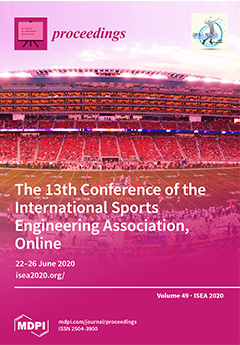The maximal total power (
Pmax) is one of the major determinants of sprint performance. It can be calculated using a simple model based on the runner’s velocity. This velocity has already been measured with force plates, video cameras or a
[...] Read more.
The maximal total power (
Pmax) is one of the major determinants of sprint performance. It can be calculated using a simple model based on the runner’s velocity. This velocity has already been measured with force plates, video cameras or a radar system, but not with an inertial system. The purpose of this study was to compare
Pmax measured with a radar system and with a multiple inertial sensors system. Seven participants (174.0 ± 6.9 cm; 67.7 ± 10.1 kg; 22.3 ± 1.7 years) realized two maximal 40-m sprints. Each athlete was equipped with an instrumented suit composed of 17 inertial measurement units (IMU) (Xsens), and a radar (Stalker ATS) was placed behind them. Both systems measured the athletes’ instantaneous horizontal velocity during the acceleration phase. Using an exponential model,
Pmax, maximal velocity (
Vmax), the slope of the exponential model (τ), maximal force (
F0) and the slope of the force, the velocity relationship (SFV) was calculated. The results showed that
Pmax,
Vmax, τ,
F0 and SFV were not significantly different between the radar and the Xsens system (
p > 0.13).
Pmax,
Vmax and
F0 measured with the radar were correlated with the same parameters measured with Xsens (r > 0.81 and
p ≤ 0.03). The IMU system can be accurately used to measure the main parameters that determine the sprint running performance:
Pmax,
Vmax and
F0. Moreover, contrary to the radar system, multiple inertial sensors will allow for an understanding of the role of the segments in maximal sprint running.
Full article



